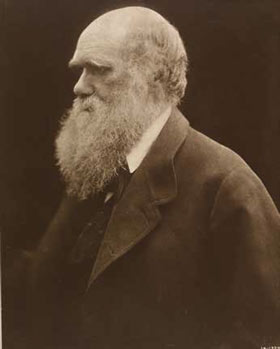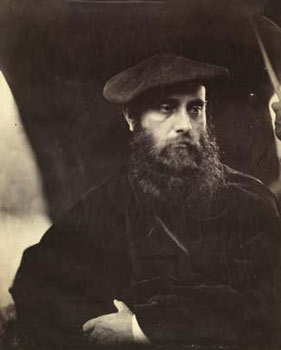articles/Exhibitions/julia-margaret-cameron-page2
Julia Margaret Cameron at 200 Years - part 2 of 1 2 3 4
Published 01/02/2016

Charles Darwin Julia Margaret Cameron 1868 printed 1875
c Victoria and Albert Museum London
The two exhibitions, one at a museum of science and the other a museum ofdesign, play into the Victorian debate that still rages now - is photographyan art or a science? That's a pretty philosophical question and straying toofar into aesthetics to do justice to here, but Cameron was very clear aboutwhich side of the divide her work fell on - it was most certainly art.
Cameron's work was different to the other Victorian photographers whosurrounded her. It had nothing of the elaborate narratives of other 'high art'photographers of the time, nor the formal poses of the commercial portraitstudios. Instead she photographed genius men of the time in daringportraits, and unknown women in elaborate biblical tableaux.
The aforementioned genius men found their own market - there was ademand for portraits of Britain's celebrities and Cameron's social circlesmeant that she was well placed to photograph these individuals. With theseportraits Cameron pioneered the art of the close-up image, filling the entireframe with the face of her sitter. She left traces of the photographic processon the chemically treated plates, showing her hand and the process ofmaking the prints. Cameron's work aspired to the creativity of painting, notthe technicality of science. Indeed she wrote to her mentor, the astronomerSir John Herschel, saying 'My aspirations are to ennoble photography andto secure it for the character and uses of high art.' We must remember atthis time that people were hostile to the idea of photography of art, seeingit merely as chemical and mechanical process. It was considered soullesscompared to the brush strokes of the Master painters.

William Michael Rossetti Julia Margaret Cameron 1865 c
Victoria and Albert Museum London
As well as portraits Cameron was also interested in 'Madonna Groups' and'Fancy Subjects for Pictorial Effect' (those are how she herself described herfavoured subjects). These creative images were often of childish bodies,posed to represent such mythical figures as Endymion or Cupid. They arethe predecessor to the modern greats such as Sally Mann with her studiesof childhood innocence, and a reflection of the Victorian obsession with theeroticised child. But the fact that Cameron was a woman brings a differentand possibly more maternal slant to the common trope of the innocenceof childhood. Compared to other photographers of the time working withchildren as their subject, such as Lewis Carroll, Cameron has attracted noreal controversy over her images.
The women in Cameron's photographs often portray the allegorical rolesof 'virtue' and 'vice'. Virtue is often expressed through the Madonna series,while Fallen Women (another Victorian obsession) represent the opposingvice. The titles often allude to the content of Cameron's pictures, suchas in the beautiful Ophelia (1868) - where the title makes us notice thewilting white rosebuds at the sitter's neck, suggesting the tragic tale ofShakespeare's Ophelia who had her life cut short in Hamlet. (Unfortunatelyyou'll have to look for that image on the internet - we could not reproduceit here.)
Perhaps the most striking feature of Cameron's work, the one that dividedthe press and so many viewers since, is the dreamlike quality given bythe lack of desire to find sharp focus throughout the entire image. 'Whenfocussing and coming to something which to my eye was beautiful Istopped there, instead of screwing on the lens to the more definite focuswhich all other photographers prefer,' wrote Cameron of her technique.This focus on what was pleasing to her rather than what was fashionable inphotography at the time has led historians to question if her eyesight haddeteriorated - as she had a family history of congenital problems. However,on reading Cameron's letters it's quite evident that her style was deliberate.'What is focus' Cameron wrote to Herschel in a letter discussing her work. '&who has the right to say what focus is the legitimate focus.'
The two exhibitions currently on show are remarkably different - especiallyconsidering that there are several of the same prints in both. The curatorshave both taken contrasting ideas and preconceptions about Cameron astheir starting points, and the two exhibitions do in many ways provide twocomplimentary views of the photographer.
Please Note:
There is more than one page for this Article.
You are currently on page 2
- Julia Margaret Cameron at 200 Years page 1
- Julia Margaret Cameron at 200 Years page 2
- Julia Margaret Cameron at 200 Years page 3
- Julia Margaret Cameron at 200 Years page 4
1st Published 01/02/2016
last update 09/12/2022 14:55:29
More Exhibitions Articles
There are 0 days to get ready for The Society of Photographers Convention and Trade Show at The Novotel London West, Hammersmith ...
which starts on Wednesday 15th January 2025





